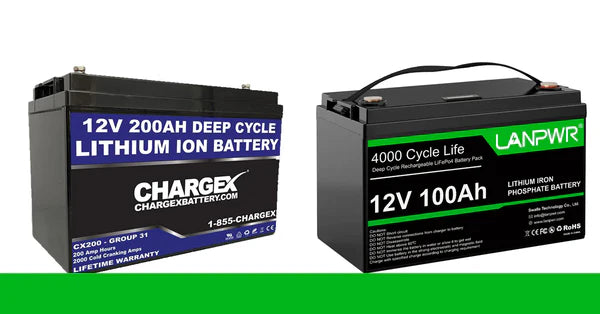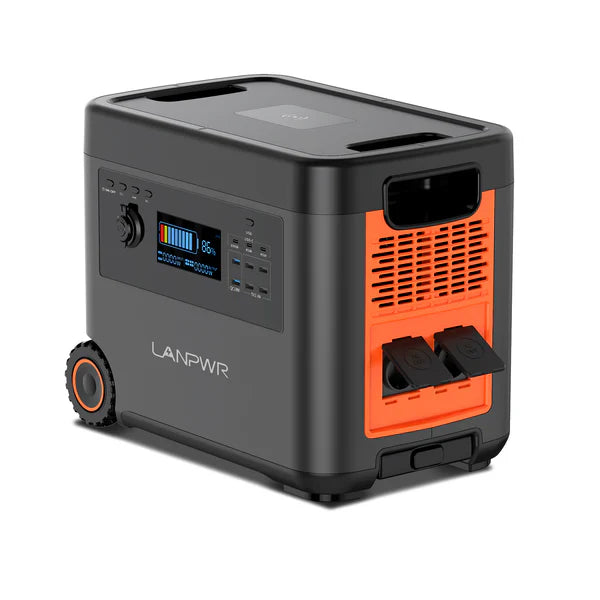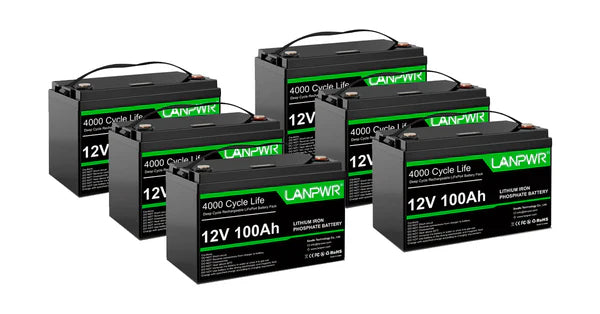When it comes to current battery technology, two types of rechargeable batteries have recently been in the spotlight: LiFePO4 (Lithium Iron Phosphate) batteries and lithium-ion batteries. While both types come with their own sets of benefits and cater to different applications, they vary quite a bit in terms of chemistry, performance characteristics, and application areas. To better understand the topic, this post walks you through the differences between LiFePO4 batteries and lithium-ion batteries, such as the pros and cons of each and appropriate use cases.
Chemistry and Composition
LiFePO4 Batteries: LiFePO4 batteries are a type of lithium-ion battery in which the cathode is specifically constructed from lithium iron phosphate (LiFePO4). Graphite is usually the anode. It is the decision to use iron phosphate (for the cathode) that separates these batteries, particularly for safety and durability.
Lithium-Ion Batteries: Lithium-ion batteries are available in various chemistries, with the most prevalent being Lithium Cobalt Oxide (LiCoO2), Lithium Manganese Oxide (LiMn2O4), and Lithium Nickel Manganese Cobalt Oxide (NMC). They generally have a graphite anode too. The battery's behavior, including its energy density, lifespan, and safety, are all influenced by its unique combination of chemicals.
LiFePO4 Batteries: Lower energy compared to other Lithium-ion batteries - Moderately high power (up to 1200 cycles) Very good capacity (80%-100% compared to nominal - 100% in comparison with Lead Acid) Can be fully recharged faster than Lead (~1C) Safety! On the low end of the spectrum, they are anywhere between 90-120 Wh/kg. Although this may seem like a disadvantage, this makes them a lot safer as they are less prone to overheating and, most importantly, thermal runaway.
Lithium-Ion Batteries: Lithium-ion batteries Lithium oxygen batteries are capable of an energy density of 150-200 Wh/kg or more, particularly lithium cobalt oxide. Their high energy density makes them perfect for use in devices where space and weight are vital, such as smartphones, laptops, and EVs. 
Cycle Life (15-20yrs)
LiFePO4 Batteries: One of the major advantages of LiFePO4 batteries is their long cycle life. They generally have a life of 2000 to 5000 charge-discharge cycles, depending on the depth of discharge and operating conditions. This makes them a natural choice for applications where long-term reliability is important, like solar energy storage systems and electric vehicle powertrains.
Regular lithium-ion batteries: Regular lithium-ion batteries have a lower life cycle than the typical LiFePO4, typically 500 to 1000 cycles. Modern batteries are constructed to last significantly longer, and with improvements in battery technology, they are only getting better. Even so, it is rare that they will be able to compete with the cycle life capabilities of LiFePO4 batteries and as such will be less suitable for high cycling applications.
Safety & Stability
LiFePO4 Batteries: When we talk about safety, LiFePO4 batteries have proven themselves to be the safest. The powerful atomic bonds that the iron phosphate demonstrates disable a key mechanism that facilitates thermal runaway — in which a battery overheats uncontrollably, sometimes triggering fires or explosions. They also are much less prone to igniting if damaged because you have to get them up to the temperature of molten iron with concentrations of pure lithium within them. They can also handle high heat without becoming dangerously unstable, another safety feature.
Lithium-Ion Batteries: Lithium-ion batteries, especially the ones with cobalt-based chemistry, are more susceptible to thermal runaway and overheating. This requires advanced Battery Management Systems (BMS) to keep an eye on and command the heat, voltage, and current of a battery. Even with these measures, there have been safety concerns related to lithium-ion battery failures, especially in high-stress applications.
Eco-friendly
LiFePO4 Batteries: LiFePO4 batteries are known for their lower environmental load compared to other lithium-based chemistries. LiFePO4 batteries use iron and phosphate, materials much more environmentally friendly and abundant than the cobalt and nickel used in other lithium-ion batteries. Another benefit is the longer lifespan of the LiFePO4 battery, which means less waste and fewer replacements over time.
Lithium-Ion Batteries: The environmental impact of lithium-ion batteries depends on which element you are interested in and its specific chemistry. Extracting cobalt, used widely in lithium-ion batteries, can create significant environmental and ethical issues given the metal's limited supply. Although there are efforts to create cobalt-free lithium-ion batteries to reduce their environmental impact, as it stands, they are less eco-friendly overall than LiFePO4 batteries.
Cost
LiFePO4 Batteries: LiFePO4 batteries have been historically cost-effective to produce due to the materials and manufacturing process. Yet their long life and additional safety often trump the high initial cost over the life of the battery. As technology progresses and production scales up, prices have been falling.
Lithium-Ion Batteries: Lithium-ion batteries, especially those with cheaper materials like manganese, tend to be cheaper to install upfront. The widespread use of lithium-ion batteries in consumer electronics has driven down costs through economies of scale. However, the shorter service life accompanied by safety risks can result in higher costs over the long term, particularly in applications that necessitate numerous replacement cycles.
Applications
As LiFePO4 batteries are safe have a long cycle life and are quite stable, they are used for Electric Vehicles (EVs): especially for safety issues and high lifespan.
Solar Energy Storage: Perfect for off-grid homes and businesses that require guaranteed and unending battery storage solutions.
Backup Power Systems: In applications such as uninterruptible power supplies (UPS) and off-grid power systems.
Marine and RV Use: A battery that needs to be capable of operating in many different conditions.
Lithium-Ion Batteries: Lithium-ion batteries are used where high energy density and low initial cost are less significant than long service life. Examples include Consumer Electronics: Including smartphones, laptops, tablets, and cameras. Portable Power Tools: Where high power output and light weight are essential.
Electric Vehicles: Particularly in models prioritizing range and performance. Grid Storage: For balancing supply and demand in large-scale energy systems, safety measures are critical.
Summary
Although LiFePO4 and lithium-ion batteries have their strengths and applications, both of them can satisfy the market to some extent. LiFePO4 batteries surpass in safety, service life, and durability, making them perfect for long-term usage and power solutions. In contrast, lithium-ion batteries are lightweight and relatively inexpensive at first glance and are therefore better suited to portable electronic devices and other applications where size and weight are important. LiFePO4 vs. Lithium-Ion—which battery to choose is extremely application-specific based on safety, life, density, or cost? With battery technology maturing at a rapid pace, we can hope that both types of batteries will be able to take advantage of the improvements that come with it and become even more viable and sustainable in a large number of applications.














Leave a comment
This site is protected by hCaptcha and the hCaptcha Privacy Policy and Terms of Service apply.